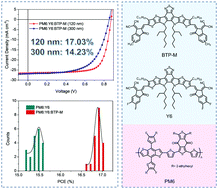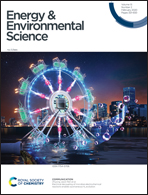Over 17% efficiency ternary organic solar cells enabled by two non-fullerene acceptors working in an alloy-like model†
Abstract
Nowadays, organic solar cells (OSCs) with Y6 and its derivatives as electron acceptors provide the highest efficiencies among the studied binary OSCs. To further improve the performances of OSCs, the fabrication of ternary OSCs (TOSCs) is a convenient strategy. Essentially, morphology control and the trade-off between voltage and photocurrent are the main critical issues in TOSCs. Herein, we address these problems by constructing TOSCs where an alloy-like composite is formed between Y6 and a newly designed derivative, BTP-M. Employing an electron-pushing methyl substituent as a replacement for the electron-withdrawing F atoms on Y6, BTP-M shows higher energy levels and lower crystallinity than Y6. As a result, the obtained Y6:BTP-M alloy can simultaneously optimize energy levels to reduce energy loss as well as the morphologies of the active layers to favor photocurrent generation, leading to an enhanced open-circuit voltage (Voc) of 0.875 V together with a larger short-circuit current density (Jsc) of 26.56 mA cm−2 for TOSCs based on the polymer donor PM6 and Y6:BTP-M acceptor alloy. Consequently, a best efficiency of 17.03% is achieved for the corresponding TOSCs, which is among the best values for single-junction OSCs. In addition, our TOSCs also exhibit good thickness tolerance, and can reach 14.23% efficiency even though the active layer is as thick as 300 nm.



 Please wait while we load your content...
Please wait while we load your content...